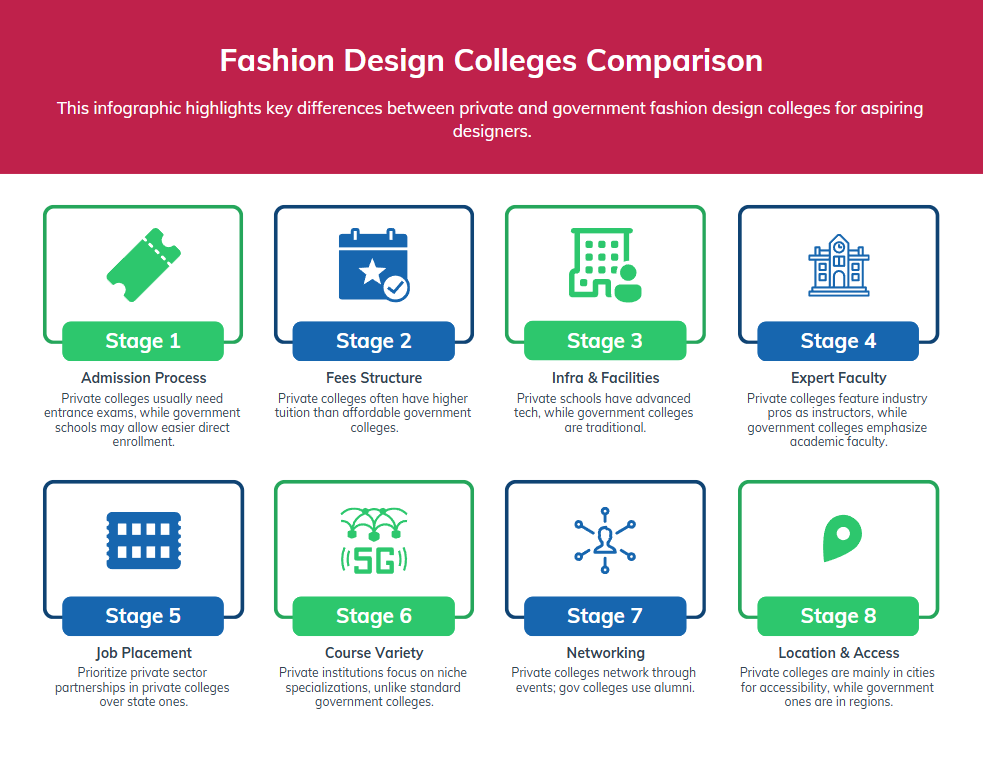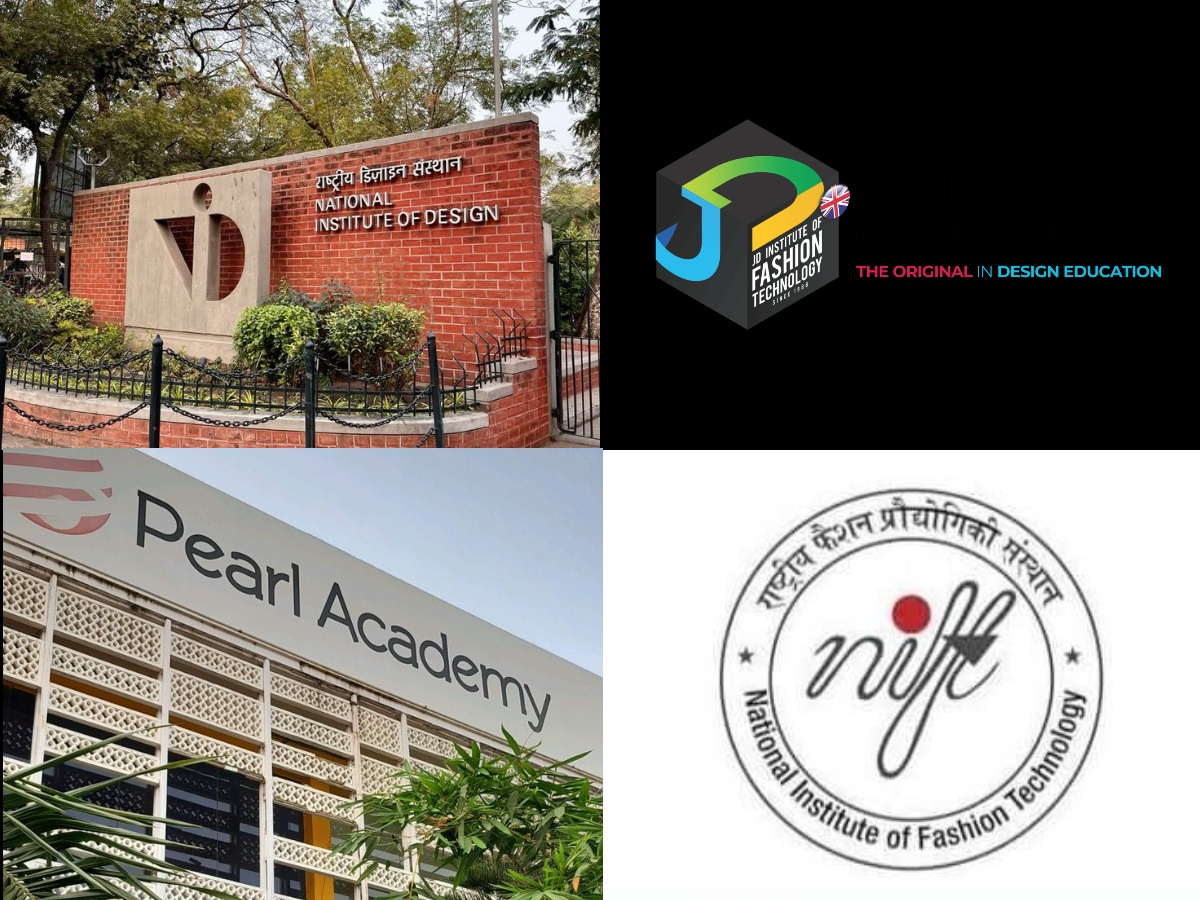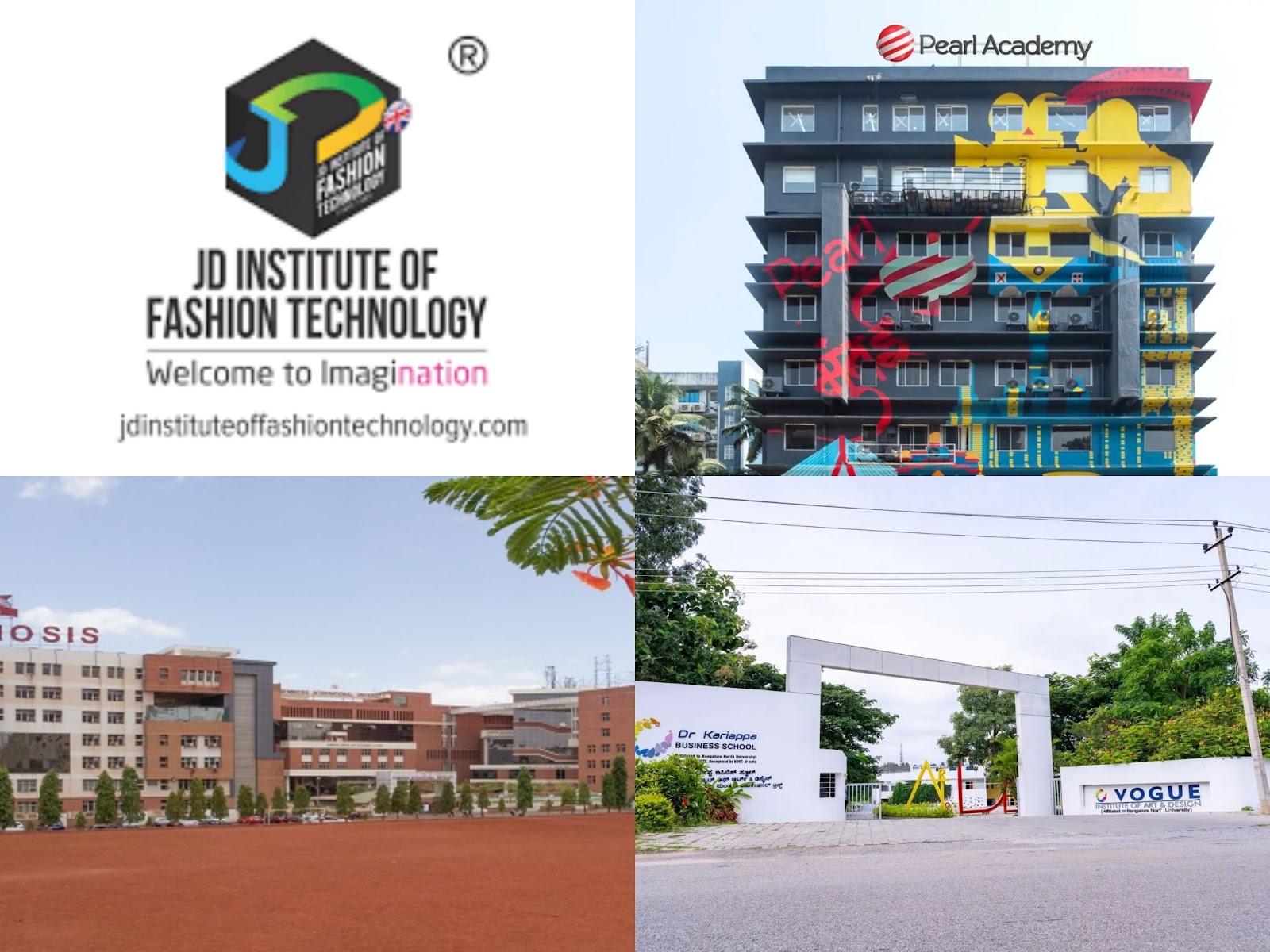So, you’re eyeing a career in fashion design? That’s fantastic! Whether you’re dreaming of creating runway masterpieces or stylish everyday outfits, the first big question is: Where should you study?

In the government vs private debate, government colleges offer affordability, respect, and great opportunities. Private colleges, on the other hand, come with modern campuses, advanced facilities, and a vibrant creative environment. It’s not just about picking a college—it’s about choosing the right place to make your fashion dreams a reality. Let’s explore which option works best for you!
Top Fashion Design Institutes: Government vs Private

Government Institutions
- National Institute of Fashion Technology (NIFT)
Established in 1986.
Campuses in Delhi, Mumbai, Bengaluru, Kolkata, and other major cities.
Offers undergraduate, postgraduate, and doctoral programs in fashion design. - National Institute of Fashion Technology (NIFT), Mumbai
Established in 1995.
Located in Navi Mumbai, Maharashtra.
Renowned for its fashion design, textile design, and fashion communication programs, with strong industry links and excellent placements. - National Institute of Fashion Technology (NIFT), Bengaluru
Established in 1997.
Located in Bengaluru, Karnataka.
Known for its state-of-the-art facilities and courses in apparel design, fashion management, and knitwear design. - National Institute of Design (NID), Ahmedabad
Established in 1961.
Located in Ahmedabad, Gujarat.
Recognized globally for its innovative programs in fashion communication, textile design, and product design, with a focus on combining traditional crafts with modern techniques. - National Institute of Design (NID), Gandhinagar
Established in 2004.
Located in Gandhinagar, Gujarat.
Specializes in postgraduate programs in lifestyle accessory design, apparel design, and strategic design management, with a strong emphasis on research and industry collaboration.
Private Institutions
- Pearl Academy
Established in 1993.
Campuses in Delhi, Noida, Jaipur, and Mumbai.
Offers a range of undergraduate, postgraduate, and diploma courses in fashion design, fashion business, and fashion styling. - Amity School of Fashion Design
Established in 2005.
Campuses in Noida, Lucknow, and other locations.
Offers undergraduate and postgraduate programs in fashion design and fashion technology. - Symbiosis Institute of Design (SID)
Established in 2004.
Located in Pune.
Offers undergraduate and postgraduate programs in design, focusing on fashion design, communication design, and product design. - Vogue Institute of Art and Design (VIFT)
Established in 1996.
Located in Bengaluru, Karnataka.
Renowned for its specialized programs in fashion design, interior design, and jewelry design, with strong industry collaborations and cutting-edge infrastructure. - JD Institute of Fashion Technology
Established in 1988.
Campuses in Mumbai, Delhi, Bengaluru, and other major cities.
Offers courses in fashion design, interior design, and product design.
How to Get In: Admission Process at Fashion Colleges

The admission process for fashion design colleges varies between government and private institutions. Government colleges like NIFT and NID rely on competitive national-level entrance exams, with strict eligibility and multiple rounds of selection, including tests, interviews, and group discussions. In contrast, private colleges often have simpler, institution-specific tests, focusing on portfolios and interviews, making it easier to get in. While government institutions offer affordability and prestige, private colleges provide flexibility and more opportunities for creative expression—so the choice depends on your style and ambitions!
| Aspect | Government Institutions | Private Institutions |
| Entrance Exams | National-level exams (NIFT, NID DAT) | Institution-specific tests (e.g., Pearl Academy) |
| Eligibility Criteria | Standardized, strict (10+2 with specific percentages) | Flexible, broader academic profiles accepted |
| Reservation Policies | Reservations for SC/ST, OBC, EWS | Limited or no reservations, focus on merit or financial capacity |
| Application Fees | Affordable (under ₹2000) | Higher (₹2000–₹5000 or more) |
| Seats Availability | Limited seats, high competition | More seats, less competition |
Understanding the Fee Differences: Government vs. Private Fashion Design Colleges

The fee structure is a major difference between government and private fashion design colleges. Government institutions like NIFT and NID are budget-friendly, with fees ranging from ₹50,000 to ₹2,50,000 per year, making quality education accessible to many. In contrast, private colleges like Pearl Academy and Amity charge significantly higher, from ₹3,00,000 to ₹7,00,000 or more annually, offering luxurious campuses and advanced facilities. While government colleges are light on the wallet, private ones promise a premium experience—choose what suits your pocket and your dream!
| Factor | Government Institutions | Private Institutions |
| Tuition Fees | ₹50,000 – ₹2,50,000 per year (varies by program & institution) | ₹3,00,000 – ₹7,00,000+ per year (some exceed ₹10,00,000) |
| Example | NIFT UG: ₹2,30,000/year (approx.) | Pearl Academy UG: ₹6,00,000/year (approx., varies by location & specialization) |
| Scholarships | Generous (government & institutional, merit & need-based) | Limited (institutional, merit & need-based) |
| Example | NIFT: “Means-Cum-Merit” scheme (need-based financial assistance) | Amity: Up to 50% tuition fees for top performersCROSS VERIFY |
| Loan Accessibility | Easier due to government affiliation | Loans available, but potentially with higher guarantees due to higher fees |
Top Fashion Design Education Standards
| Aspect | Government Institutions | Private Institutions |
| Curriculum | Well-structured, industry-focused, standardized | Dynamic, updated with latest trends and technology |
| Faculty Expertise | Highly qualified, experienced, industry leaders | Qualified, some industry professionals, varies by institution’s reputation |
| Practical Exposure | Strong focus on hands-on learning, workshops, internships, live projects | Emphasis on practical exposure, collaborations with designers, brands, and events |
Fashion Design Colleges and Their Infrastructure and Facilities
When it comes to infrastructure and facilities, government fashion colleges provide functional setups with well-equipped classrooms and basic labs, focusing on practicality. On the flip side, private institutions dazzle with modern, stylish campuses featuring state-of-the-art design labs, 3D printing tools, and multimedia studios that scream creativity. While government colleges prioritize functionality, private ones offer a trendy vibe, reflecting the industry’s glamour. Your choice depends on whether you value a grounded approach or a cutting-edge creative space!
| Factor | Government Institutions | Private Institutions |
| Campus Facilities | Basic, functional (classrooms, libraries, workshops) | Modern, advanced (design labs, multimedia studios, auditoriums) |
| Design Studios & Labs | Necessary tools with upgrades being made in technological advancements | State-of-the-art, access to latest tech, CAD software, high-end equipment |
| Industry Exposure | Strong connections, government partnerships, collaborations with fashion houses | High focus on internships, industry collaborations, fashion events, shows |
| Campus Aesthetic | Simple, functional design | Trendy, modern, stylish, reflects fashion-forward nature |
Career Opportunities and Industry Exposure in Fashion Design: Government vs Private Colleges
Career opportunities in fashion designing vary depending on whether you study at a government or private college. Government institutions like NIFT and NID offer strong placement networks with top brands like H&M, Zara, and Fabindia, thanks to their reputation and alumni base. Private colleges, such as Pearl Academy or Amity, provide exposure to luxury brands, startups, and even international roles through creative collaborations and global programs. While government colleges focus on traditional roles in design and textiles, private ones open doors to modern careers like fashion styling, influencer marketing, and digital fashion design, letting you pick the path that suits your passion.
| Factor | Government Institutions | Private Institutions |
| Placements | Strong due to established connections (NIFT, NID) | Varies by reputation (top colleges have strong networks) |
| Industry Exposure | Extensive through collaborations, events, alumni networks | Strong focus through internships, fashion shows, collaborations |
| Brand Value & Alumni | High global recognition (NIFT, NID) | Gaining recognition (Raffles, Amity), varies by institution |
| Global Opportunities | Opportunities abroad with multinational companies | International opportunities through exchange programs, collaborations (varies by college) |
Student Reviews and Experiences

Government Institutions (e.g., NIFT, NID)
Here’s what people on google have to say about Government Fashion Designing institutes
Harris Lawrains on NIFT Gandhinagar
NIFT is a pioneering institute of fashion education in India and has been in the vanguard of providing professional human resources to the textile, apparel, fashion and accessories industry.
NIFT offers Bachelors, Masters, Certificate courses and training programs in design, management and technology.
Prashant Karandikar on NIFT Mumbai
NIFT – National Institute of Fashion Technology at Kharghar, Mumbai is located in the institutional sector in Kharghar. Was here for the entrance exam for the graduation course.
Avinash Pardhi on NID Ahmedabad
Beautiful green campus of the prestigious institute on the banks of Sabarmati, in the middle of the city. One can feel the drop in temperature soon after entering the campus. Wonderful environment to mold the careers and rejuvenate creative juices in the talented minds of our future designers.
Pradip Singh on NID Ahmedabad
NID ,Ahmedabad is one of the premier Design Institute of India & South Asia which produced a no of talents in various designs – production,Apparel,textile ,photography ,industrial etc .
I am one of the proud parents who got an opportunity to get study of my daughter from Gandhinagar campus,linked to NID,Ahmedabad.
Private Institutions (e.g., Pearl Academy, Amity, JD Institute)
Here’s what people on google have to say about Private Fashion Designing institutes
Jayasankar Variyar on Amity School of Fashion Design, Mumbai
Excellent facilities with diverse schools. Multidisciplinary focus with holistic growth of the student. NCC NSS village adoption legal aid up-skilling on technical areas help the students get practice.
Pallavi Mishra on Vogue Institute of Art and Design (VIFT),Pune
One of the best designing college with corporate experience faculties…lots of practical exposure and chance to meet,and gain knowledge from the prominent personalities of fashion industry
Kavita Patel on JD Institute of Fashion Technology, Mumbai
JD’s it’s an Amazing Institution for those looking for a career in the Fashion Industry. Here it’s Much more than a Training Centre. Here is Creative Campus for all you who are visionary about their Bright And Creative World of FASHION, CULTURE, STYLE,LOOKS AND TRENDY. Go and Grab the Skills and Become the Trendsetter with the AMAZING LEADERS of The INSTITUTE.
Top Recruiters in Government and Private Colleges
Placement Procedure and Companies

- Click on the Registration Link:
Begin your registration by accessing the official registration page (Link will be provided on the official website). - Upload Your Resume and Portfolio:
Submit an updated resume along with a creative portfolio showcasing your best work. - Get Groomed with Our CV Building:
Receive expert guidance to enhance your CV and create a lasting impression. - Portfolio Review and Mock Sessions:
Get constructive feedback on your portfolio and take part in mock sessions for improvement. - Connect with Industry Experts:
Gain valuable insights and personalized advice from experienced industry professionals.

Government Institutions (e.g., NIFT, NID)
Here’s a list of placement companies that hire students from government institutions
Fashion Houses:
- Manish Malhotra
- Sabyasachi
- Ritu Kumar
- Tarun Tahiliani
- Anita Dongre
- Anamika Khanna
- House of Masaba
Companies:
- Shoppers Stop
- Pantaloons
- Aditya Birla Fashion & Retail
- Amazon
- Reliance Trends
- Tata Group
- Raymond
- Myntra
- Zara
- H&M
- Levi’s
- Puma
- Nike
- Reebok
- Pepe Jeans
- Abercrombie & Fitch
- Forever 21
- Lifestyle
- Vero Moda
- Jack & Jones
- Marks & Spencer
- Benetton
- Van Heusen
- Pantone
- Wipro
- Tata Elxsi
- Genpact
- Schbang Digital Solutions
- Deloitte
These organizations recruit for positions in fashion design, merchandising, retail management, and textile technology.
Private Institutions (e.g. Amity, Symbiosis, JD Institute)

Pearl Academy:
Pearl Academy offers placements with top industry names, including:
- Shoppers Stop
- Aditya Birla Group
- Pantaloons
- H&M
- Zara
- Ralph Lauren
- Forever 21
- Levi’s
- Reliance Trends
- Tata Group
Symbiosis Institute of Design (SID):
Symbiosis Institute of Design has strong industry connections with top companies such as:
- Greentech Solutions
- Inteliment
- Crompton Greaves Consumer Electricals Ltd
- IBM
- Tata Elxsi
- Genpact
- Schbang Digital Solutions Pvt Ltd
- Siemens
- 9. STAC Fine Jewellery
- 10. Length Breadth Height
- 11. Deloitte
- 12. Adhya Design Pvt. Ltd.
- 13. Astre D’orr
- 14. Acuiti Labs
- 15. Avataar
Vogue Institute of Art and Design (VIFT):
Vogue Institute has partnerships with a variety of fashion and design companies for placements, including:
- Tommy Hilfiger
- Levi’s
- Shoppers Stop
- Lifestyle
- Reliance Trends
- Raymonds
- Wills Life Style
- Big Bazaar
- Amazon
- Malabar Gold
- Mysore Saree Udyog
- Gokaldas Images
- Texport
- Wipro
- H&M
- P N Rao
- Indus Fila
- Raymond
- Puma
- Neelkanth Jewellers
JD Institute of Fashion Technology:
JD Institute of Fashion Technology has collaborations with several leading brands for student placements, including:
- Shoppers Stop
- H&M
- Zara
- Fabindia
- Pantaloons
- Wipro
- Aditya Birla Fashion & Retail
- Amazon
- Van Heusen
- Biba
- Liva
- Lifestyle,etc
Key Differences in Placement Opportunities
Government Colleges: More structured placement processes and established recruiters, with a focus on traditional roles in fashion design, textile development, and merchandising.
Private Colleges: Wider range of opportunities, including unconventional roles like fashion blogging, influencer marketing, and digital fashion design, but placement rates can vary by college.


Superb website you have here but I was wondering if
you knew of any discussion boards that cover the same topics talked about here?
I’d really like to be a part of community where I can get comments from other experienced people that share
the same interest. If you have any recommendations, please let me know.
Bless you!
Stop by my website; $1 links